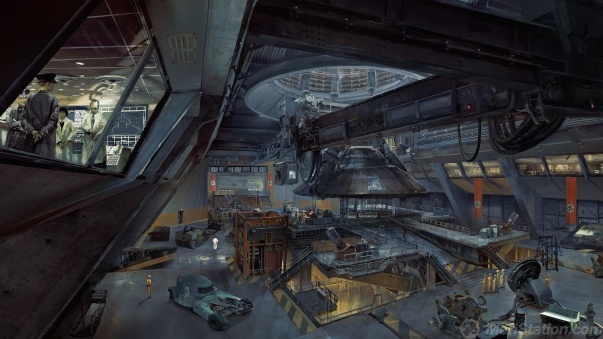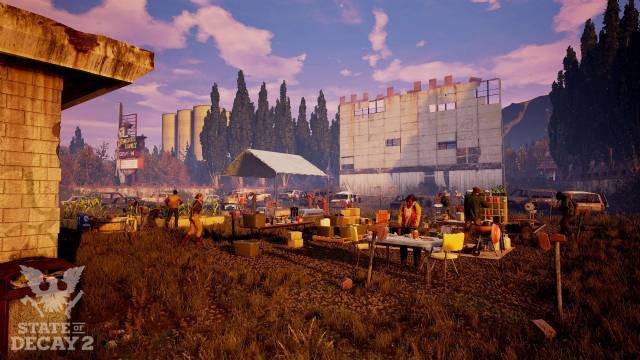A last fortnight of October hard to forget for video game fans. Just when announcing the closure of Visceral Games and EA decided to leave the game single player of Star Wars, (because apparently the titles for a single player “do not fit the model of video game asked by the user today”), We received Super Mario Odyssey . And the new Assassin’s Creed. An
d the new Wolfenstein . Three bets that overlap part of their audience but with clearly differentiated market targets; three bets that base their structure and their success on the experience for a single player. And in the case of Wolfenstein II, prepared to satisfy the most demanding palates hungry for old-school shooter.
After the surprising The New Order there was great expectation about MachineGamesand about what they could do with more time and more budget, and both have been well used; Colossus develops from the events of the first one, obliging us, however, to resume one of the great decisions that were left of it and that will directly affect our crew and the arsenal that
we will have in combat. The principle of the game is a statement of intent for the player: 1) there will be no concessions in term
s of violence and brutality on the screen. 2) The game has some comic counterpoint but it takes itself much more seriously than we imagined and 3) we immediately know that it does not offer any kind of ideological ambiguity so fashionable in rece
nt times. Wolfenstein is a saga where the Nazis are the very bad ones and killing them all is the right thing to do.This game is one of the best playable experiences we have had with a shooter since, possibly, Doom.
This is a game not suitable for all audiences : it is explicit, it is grotesque, it is brutal. There is alcohol, partial nakedness, implicit sex, drug use.
There are beheadings in the first person, there are mutilated members, there are heads split in half with an ax. We can even run with our “American football” armor and literally decompose an opponent without armor. And there is, of course, racism, anti-Semitism, ho
mophobia, capacitism, humiliations of all kinds. There are, in short, Nazis exercising Nazis. It is not free, because all the staging has its reason, but it must be clear if someone is thinking about acquiring this game for the little nephew or for his minor godson.
Blazkowic, the new colossus
Impeded in a wheelchair, maneuvering with one hand through the narrow corridors of the largest submarine ever built while, with the other, we shot our Maschinenpistole – SMG – to the first Nazis who try to end the little life we have left. That is the premise with the
player starts to handle Blazkowic, almost fallen hero who notes during much of the game that his days on earth are running out. The fight against the Nazis is another one of those that our hero supports, that in addition has to battle with the imminent fragility of his battered body after the incidents of the previous game. And is that nobody in The New Colossus has been
unscathedafter the fictional alternative story presented by the German victory in the Second World War. Everyone, without exception, shows signs and scars – physical or psychological – after years of occupation. Each character, each m
emory, each flashback, each conversation … all distill the ravages of more than 20 years of holocaust. And that feeling is set there so that there is no hint of doubt when you press the trigger.
Wolfenstein is an action game, to be clear, but there is a great effort in there to tell a story. The interpretation by the actors is superb, frankly the best we’ve seen in a video game lately and highlighting especially the villain, Frau Engels. The
action arrives dosed to impulses, with intervals interrupted by kinematics or by phases of “cooling” in the Eva’s Hammer, the submarine. And there is a limit of adrenaline that the player can endure, so the management and balance of time is somethi
ng that we also think is a great success. Even the comic release is meticulously calculated at the time of introducing it in the narrative of the game: it is not a histrionic video game and, nevertheless,Duke Nukem Forever would have liked to be able to let loose some laughter.
This is Wolfenstein, not Deus EX.
Wolfenstein II is configured so that the player can choose the path that best suits their style of play . Obviously this is not Deus Ex: although there is an option to take stealthier paths, eventually we will end up firing. And we’re going
to end up shooting a lot. But it is true that the levels have been designed to allow, in many cases, more than one approach to a meeting. This is probably one of the great advantages of designing scenarios without having to think about having to reuse them
as multiplayer maps: the ability to provide complete and tailor-made experiences according to the narrative need and not according to the n
eed to reduce costs. The scenarios are phenomenally represented, from the decadent post-nuclear New York to the Nazi technology mix of science fiction from the 60s and the Second World War.
But we can not forget that even with its many possibilities. all that makes The New Colossus is wrapped in a large “hall” that suppose the levels , detailed that yes until the last corner and hiding place that only after certain scrutiny we will achie
ve. Wolfenstein is a game to go from A to B, that is clear to everyone, with the possibility of deviating a little along the way, yes, but it is a gigantic a
nd beautiful corridor with flourishes. In fact, one of the criticisms that can be made to the title is that the fact of making the scenarios almost completely pre-rendered is their
limited ability to interact with them., which takes away some credibility. Some boxes are destroyed and a picture falls, of course, but the sense of power that we have using weapons against our enemies is lost when we interact with the world tha
t the game proposes. On one occasion, for example, while stealthily advancing on the hunt for an enemy Überkommandant, a lamp illuminated our face, taking away our vision; We try to shoot unsuccessfully in the light to destroy it, leaving in evidence the limitations of ID Tech-6.
Most of the missions are divided into a succession of encounters, a formula that worked so well for DOOM . On many occasions, a notice in the HUD gives us the address to which the commander or the enemy commanders are and we have t
o manage them across the stage to reach them; if we are detected, which will be the most normal, we must open the way by force and also face thei
r reinforcements, which are usually of higher rank: soldiers with weapons and various armor, supersoldiers product of Nazi experimentation, normal dogs, robot dogs, giant robot dogs … either way, the music is responsible for raising the tension while the alarm sounds and we are ready to fight.


